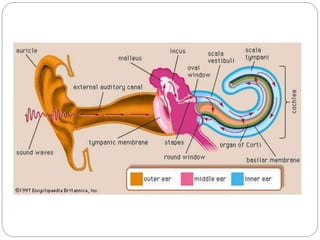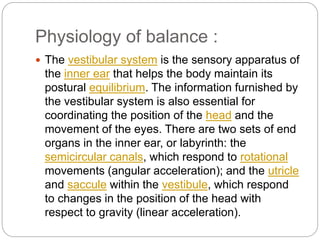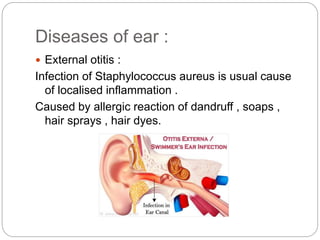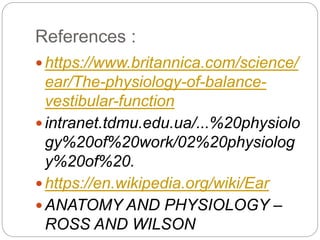The document discusses the anatomy and physiology of the human ear. It describes the three main parts of the ear - the outer, middle, and inner ear. The outer ear collects sound waves. The middle ear contains three small bones that transmit vibrations through the inner ear. The inner ear contains fluid-filled structures, including the cochlea, that transduce vibrations into nerve signals for hearing and balance. The document also briefly discusses common ear disorders like infections and deafness.
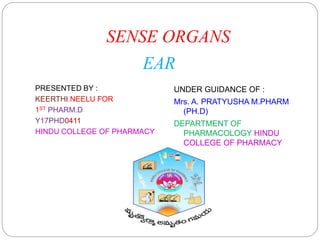

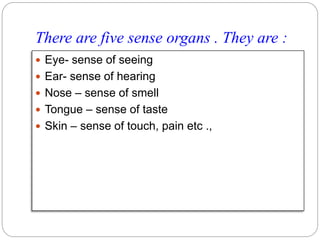
![Now we will discuss about ear
The ear is organ of hearing
Supplied by 8th cranial nerve, i.e. the cochlear
part of vestibulocochlear nerve which is
stimulated by vibrations caused by sound waves
Exception of auricle [pinna] structures that form
ear are encased within petrous portion of
temporal bone](https://image.slidesharecdn.com/senseorgans-ear-190127050508/85/Sense-organs-ear-4-320.jpg)
![STRUCTURE OF EAR : They are 3 parts
OUTER EAR
MIDDLE EAR [tympanic cavity]
INNER EAR](https://image.slidesharecdn.com/senseorgans-ear-190127050508/85/Sense-organs-ear-5-320.jpg)


![MIDDLE EAR :
Middle ear
Main article: Middle ear
The middle ear
The middle ear lies between the outer ear and the inner ear. It consists of an air-
filled cavity called the tympanic cavity and includes the three ossicles and their
attaching ligaments; the auditory tube; and the round and oval windows. The
ossicles are three small bones that function together to receive, amplify, and
transmit the sound from the eardrum to the inner ear. The ossicles are the
malleus (hammer), incus (anvil), and the stapes (stirrup). The stapes is the
smallest named bone in the body. The middle ear also connects to the upper
throat at the nasopharynx via the pharyngeal opening of the Eustachian tube.[3][7]
The three ossicles transmit sound from the outer ear to the inner ear. The
malleus receives vibrations from sound pressure on the eardrum, where it is
connected at its longest part (the manubrium or handle) by a ligament. It
transmits vibrations to the incus, which in turn transmits the vibrations to the
small stapes bone. The wide base of the stapes rests on the oval window. As the
stapes vibrates, vibrations are transmitted through the oval window, causing
movement of fluid within the cochlea.[3]
The round window allows for the fluid within the inner ear to move. As the stapes
pushes the secondary tympanic membrane, fluid in the inner ear moves and
pushes the membrane of the round window out by a corresponding amount into
the middle ear. The ossicles help amplify sound waves by nearly 15–20 times.[2]](https://image.slidesharecdn.com/senseorgans-ear-190127050508/85/Sense-organs-ear-8-320.jpg)

![The inner ear sits within the temporal bone in a complex cavity
called the bony labyrinth. A central area known as the vestibule
contains two small fluid-filled recesses, the utricle and saccule.
These connect to the semicircular canals and the cochlea.
There are three semicircular canals angled at right angles to
each other which are responsible for dynamic balance. The
cochlea is a spiral shell-shaped organ responsible for the
sense of hearing. These structures together create the
membranous labyrinth.[8]
The bony labyrinth refers to the bony compartment which
contains the membranous labyrinth, contained within the
temporal bone. The inner ear structurally begins at the oval
window, which receives vibrations from the incus of the middle
ear. Vibrations are transmitted into the inner ear into a fluid
called endolymph, which fills the membranous labyrinth. The
endolymph is situated in two vestibules, the utricle and
saccule, and eventually transmits to the cochlea, a spiral-
shaped structure. The cochlea consists of three fluid-filled
spaces: the vestibular duct, the cochlear duct, and the
tympanic duct.[3] Hair cells responsible for transduction—
INNER EAR :](https://image.slidesharecdn.com/senseorgans-ear-190127050508/85/Sense-organs-ear-10-320.jpg)


